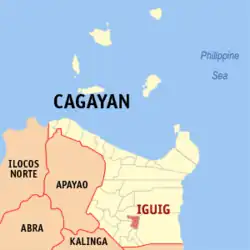Iguig
Iguig (Ibanag: Ili nat Iguig; Ilocano: Ili ti Iguig; Tagalog: Bayan ng Iguig), officially the Municipality of Iguig, is a 4th class municipality in the province of Cagayan, Philippines. According to the 2020 census, it has a population of 30,060 people.[3]
Iguig | |
|---|---|
| Municipality of Iguig | |
 St. James the Apostle Parish in Calvary Hills | |
 Flag  Seal | |
| Nickname: Pottery Center of Cagayan | |
 Map of Cagayan with Iguig highlighted | |
OpenStreetMap | |
.svg.png.webp) Iguig Location within the Philippines | |
| Coordinates: 17°45′06″N 121°44′11″E | |
| Country | Philippines |
| Region | Cagayan Valley |
| Province | Cagayan |
| District | 3rd district |
| Founded | December 28, 1607 |
| Barangays | 23 (see Barangays) |
| Government | |
| • Type | Sangguniang Bayan |
| • Mayor | Ferdinand B. Trinidad |
| • Vice Mayor | Juditas L. Trinidad |
| • Representative | Joseph L. Lara |
| • Electorate | 18,167 voters (2022) |
| Area | |
| • Total | 108.10 km2 (41.74 sq mi) |
| Elevation | 34 m (112 ft) |
| Highest elevation | 143 m (469 ft) |
| Lowest elevation | 8 m (26 ft) |
| Population (2020 census)[3] | |
| • Total | 30,060 |
| • Density | 280/km2 (720/sq mi) |
| • Households | 7,015 |
| Economy | |
| • Income class | 4th municipal income class |
| • Poverty incidence | 11.12 |
| • Revenue | ₱ 130.6 million (2020) |
| • Assets | ₱ 335.8 million (2020) |
| • Expenditure | ₱ 129.1 million (2020) |
| • Liabilities | ₱ 196.7 million (2020) |
| Service provider | |
| • Electricity | Cagayan 1 Electric Cooperative (CAGELCO 1) |
| Time zone | UTC+8 (PST) |
| ZIP code | 3504 |
| PSGC | |
| IDD : area code | +63 (0)78 |
| Native languages | Ibanag Ilocano Tagalog |
| Website | www |
It is best known as the hometown of Dado Banatao, a well-known Filipino-American software engineer credited for having developed the first 10-Mbit Ethernet CMOS with silicon coupler data-link control and transreceiver chip.[5]
Iguig is 14 kilometres (8.7 mi) from Tuguegarao and 495 kilometres (308 mi) from Manila.
History
Iguig was officially established as a Spanish mission on 16 April 1608.[6] The name of the town is said to mean "the place of Ig", referring to a native chieftain and warrior who lived in the area.[7]
Geography
Barangays
Iguig is politically subdivided into 23 barangays. Each barangay consists of puroks while some have sitios.
- Ajat (Poblacion)
- Atulu
- Baculud
- Bayo
- Campo
- Dumpao
- Gammad
- Garab
- Malabbac
- Manaoag (Aquiliquilao)
- Minanga Norte
- Minanga Sur
- Nattanzan (Poblacion)
- Redondo
- Salamague
- San Esteban (Capitan)
- San Isidro (Ugac West)
- San Lorenzo
- San Vicente (Ugac East)
- Santa Barbara
- Santa Rosa
- Santa Teresa (Gammad Sur)
- Santiago
Climate
| Climate data for Iguig, Cagayan | |||||||||||||
|---|---|---|---|---|---|---|---|---|---|---|---|---|---|
| Month | Jan | Feb | Mar | Apr | May | Jun | Jul | Aug | Sep | Oct | Nov | Dec | Year |
| Average high °C (°F) | 25 (77) |
26 (79) |
28 (82) |
31 (88) |
32 (90) |
31 (88) |
31 (88) |
30 (86) |
30 (86) |
28 (82) |
27 (81) |
25 (77) |
29 (84) |
| Average low °C (°F) | 21 (70) |
21 (70) |
22 (72) |
23 (73) |
24 (75) |
25 (77) |
24 (75) |
25 (77) |
24 (75) |
23 (73) |
23 (73) |
22 (72) |
23 (74) |
| Average precipitation mm (inches) | 155 (6.1) |
113 (4.4) |
89 (3.5) |
58 (2.3) |
127 (5.0) |
131 (5.2) |
154 (6.1) |
184 (7.2) |
151 (5.9) |
247 (9.7) |
221 (8.7) |
292 (11.5) |
1,922 (75.6) |
| Average rainy days | 19.6 | 14.8 | 13.4 | 12 | 19.4 | 19.8 | 23 | 25.0 | 23 | 19.4 | 19.1 | 21.6 | 230.1 |
| Source: Meteoblue[8] | |||||||||||||
Demographics
|
| |||||||||||||||||||||||||||||||||||||||||||||||||||
| Source: Philippine Statistics Authority[9][10][11][12] | ||||||||||||||||||||||||||||||||||||||||||||||||||||
In the 2020 census, the population of Iguig was 30,060 people,[3] with a density of 280 inhabitants per square kilometre or 730 inhabitants per square mile.
Economy
Government
Local government
Iguig, belonging to the third legislative district of the province of Cagayan, is governed by a mayor designated as its local chief executive and by a municipal council as its legislative body in accordance with the Local Government Code. The mayor, vice mayor, and the councilors are elected directly by the people through an election which is being held every three years.
Elected officials
| Position | Name |
|---|---|
| Congressman | Joseph L. Lara |
| Mayor | Ferdinand B. Trinidad |
| Vice-Mayor | Juditas L. Trinidad |
| Councilors | Ma. Riza Lyn B. Callueng |
| Benjamin C. Pascual Jr. | |
| Juliet P. Barizo | |
| Juanito P. Ramos | |
| Mario B. Pelovello | |
| Raul B. Trinidad | |
| Marcial P. Liquigan | |
| Ventura D. Zinampan | |
Education
The Schools Division of Cagayan governs the town's public education system.[21] The division office is a field office of the DepEd in Cagayan Valley region.[22] The office governs the public and private elementary and public and private high schools throughout the municipality.
References
- Municipality of Iguig | (DILG)
- "2015 Census of Population, Report No. 3 – Population, Land Area, and Population Density" (PDF). Philippine Statistics Authority. Quezon City, Philippines. August 2016. ISSN 0117-1453. Archived (PDF) from the original on May 25, 2021. Retrieved July 16, 2021.
- Census of Population (2020). "Region II (Cagayan Valley)". Total Population by Province, City, Municipality and Barangay. Philippine Statistics Authority. Retrieved 8 July 2021.
- "PSA Releases the 2018 Municipal and City Level Poverty Estimates". Philippine Statistics Authority. 15 December 2021. Retrieved 22 January 2022.
- "About the Organization".
- Salgado, Pedro. "Other Missions in Cagayan Province". Cagayan Valley and Easter Cordillera: 1581-1898, Volume I. Rex Publishing. p. 338.
- de Rivera Castillet, Ed. Cagayan Province and her People. Community Publishers.
- "Iguig, Cagayan: Average Temperatures and Rainfall". Meteoblue. Retrieved 3 November 2018.
- Census of Population (2015). "Region II (Cagayan Valley)". Total Population by Province, City, Municipality and Barangay. Philippine Statistics Authority. Retrieved 20 June 2016.
- Census of Population and Housing (2010). "Region II (Cagayan Valley)" (PDF). Total Population by Province, City, Municipality and Barangay. National Statistics Office. Retrieved 29 June 2016.
- Censuses of Population (1903–2007). "Region II (Cagayan Valley)". Table 1. Population Enumerated in Various Censuses by Province/Highly Urbanized City: 1903 to 2007. National Statistics Office.
- "Province of Cagayan". Municipality Population Data. Local Water Utilities Administration Research Division. Retrieved 17 December 2016.
- "Poverty incidence (PI):". Philippine Statistics Authority. Retrieved December 28, 2020.
- "Estimation of Local Poverty in the Philippines" (PDF). Philippine Statistics Authority. 29 November 2005.
- "2003 City and Municipal Level Poverty Estimates" (PDF). Philippine Statistics Authority. 23 March 2009.
- "City and Municipal Level Poverty Estimates; 2006 and 2009" (PDF). Philippine Statistics Authority. 3 August 2012.
- "2012 Municipal and City Level Poverty Estimates" (PDF). Philippine Statistics Authority. 31 May 2016.
- "Municipal and City Level Small Area Poverty Estimates; 2009, 2012 and 2015". Philippine Statistics Authority. 10 July 2019.
- "PSA Releases the 2018 Municipal and City Level Poverty Estimates". Philippine Statistics Authority. 15 December 2021. Retrieved 22 January 2022.
- "2019 National and Local Elections" (PDF). Commission on Elections. Retrieved March 10, 2022.
- "History of DepED SDO Cagayan". DepED SDO Cagayan | Official Website of DepED SDO Cagayan. Retrieved March 13, 2022.
- "DEPED REGIONAL OFFICE NO. 02". DepED RO2 | The official website of DepED Regional Office No. 02.
External links
 Media related to Iguig at Wikimedia Commons
Media related to Iguig at Wikimedia Commons- Philippine Standard Geographic Code
- Philippine Census Information